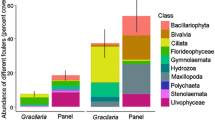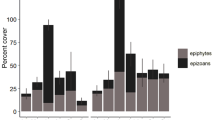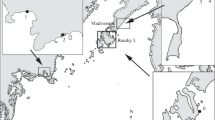Abstract
Ascidian specimens were collected from the Indian River Lagoon, Florida, USA, in November 1987. Eudistoma olivaceum (Van Name) was fouled by only two species of epifaunal invertebrates and the percent cover of epibionts was negligible. Colonies of E. capsulatum (Van Name) were fouled by up to 17 species of epifaunal invertebrates, epibionts covered an average of 12.5% of the surface area of these colonies. Extracts of E. olivaceum exhibited potent cytotoxic, antimicrobial and antiviral activity in laboratory bioassays, while the activity of extracts of E. capsulatum was insignificant. The toxicity of extracts of each ascidian was negatively related to the percent cover of fouling organisms. Surface acidity of each ascidian was positively related to the percent cover of epibionts: E. olivaceum was nearly neutral (pH=6), while E. capsulatum was highly acidic (pH=1 to 2). Larval settlement and growth of ancestrulae of the cheilostome bryozoan Bugula neritina (Linnaeus) were inhibited at very low concentrations of crude extract of E. olivaceum. Crude extracts of E. capsulatum inhibited settlement and growth of B. neritina only at concentrations of approximately an order of magnitude greater than those of E. olivaceum. Differences in the degree to which these congeneric ascidians are fouled is related to differences in the chemical defenses they possess. Acidity is not an effective inhibitor of settlement by epifaunal invertebrates.
Similar content being viewed by others
Literature cited
Alley, M. C., Scudiero, D. A., Monks, A., Hursey, M. L., Czerwinski, M. J., Fine, D. L., Abbot, B. J., Mayo, J. G., Shoemaker, R. H., Boyd, M. R. (1988). Feasibility of drug screening with panels of human tumor cell lines using a microculture tetrazolium assay. Cancer Res. 48: 589–601
Bakus, G. J., Targett, N. M., Schulte, B. (1986). Chemical ecology of marine organisms: an overview. J. chem. Ecol. 12: 951–987
Buss, L. W. (1979). Habitat selection, directional growth and spatial refuges: why colonial animals have more hiding places. In: Larwood, G., Rosen, B. R. (eds.) Biology and systematics of colonial organisms. Academic Press, London, p. 459–497
Connell, J. H. (1985). The consequences of variation in initial settlement vs. post-settlement mortality in rocky intertidal communities. J. exp. mar. Biol. Ecol. 93: 11–45
Crisp, D. J. (1984). Overview of research on marine invertebrate larvae. 1940–1980. In: Costlow, J. D., Tipper, R. C. (eds.) Marine biodeterioration: an interdisciplinary study. Naval Institute Press, Annapolis, Maryland, USA, p. 103–126
Davis, A. R. (1987). Variation in recruitment of the subtidal colonial ascidian Podoclavella cylindrica (Quoy and Gaimard: the role of substratum choice and early survival. J. exp. mar. Biol. Ecol. 106: 57–71
Davis, A. R. (1988). Effects of variation in initial settlement on distribution and abundance of Podoclavella moluccensis Sluiter. J. exp. mar. Biol. Ecol. 117: 157–167
Davis, A. R., Wright, A. E. (1988). Ascidian antifouling defenses: surface acidity vs. secondary metabolits. Am. Zool. 28: p. 70A
Dyrynda, P. E. J. (1986). Defensive strategie of modular organisms. Phil. Trans. R. Soc. (Ser. B) 313: 227–243
Jackson, J. B. C. (1977). Competition on marine hard substrata: the adaptive significance of solitary and colonial strategies. Am. Nat. 111: 743–767
Jackson, J. B. C., Buss, L. W. (1975). Allelopathy and spatial competition among coral reef invertebrates. Proc. natn. Acad. Sci. USA 72: 5160–5163
Kinzer, K. F., Cardellina, J. H., II. (1987). Three new B-carbolines from the Bermudian tunicate Eudistoma olivaceum. Tetrahedron Lett. 28: 925–926
Maki, J. S., Rittschof, D., Costlow, J. D., Mitchell, R. (1988). Inhibition of attachment of larval barnacles, Balanus amphitrite, by bacterial surface films. Mar. Biol. 97: 199–206
McCaffrey, E. J., Endean, R. (1985). Antimicrobial activity of tropical and subtropical sponges. Mar. Biol. 89: 1–8
Parry, D. L. (1984). Chemical properties of the test of ascidians in relation to predation. Mar. Ecol. Prog. Ser. 17: 279–282
Rinehart, K. L., Jr., Kobayashi, J., Harbour, G. C., Gilmore, J., Mascal, M., Holt, T. G., Shield, L. S., Lafargue, F. (1987). Eudistomins A-Q, B-carbolines from the antiviral Caribbean tunicate Eudistoma olivaceum. J. Am. chem. Soc. 109: 3378–3387
Rinehart, K. L., Jr., Kobayashi, J., Harbour, G. C., Hughes, Robert G., Jr., Mizsak, S. A., Scahill, T. A. (1984). Eudistomins C, E, K, and L, potent antiviral compounds containing a novel oxathiazepine ring from the Caribbean tunicate Eudistoma olivaceum. J. Am. chem. Soc. 106: 1524–1526
Russell, W. C. (1962). A sensitive and precise plaque assay for Herpes virus. Nature, Lond. 195: 1028–1029
Stoecker, D. (1978). Resistance of a tunicate to fouling. Biol. Bull. mar. biol. Lab., Woods Hole 155: 615–626
Stoecker, D. (1980). Relationships between chemical defense and ecology in benthic ascidians. Mar. Ecol. Prog. Ser. 3: 257–265
Thompson, J. E., Walker, R. P., Faulkner, D. J. (1985). Screening and bioassays for biologically-active substances from forty marine sponge species from San Diego, California, USA. Mar. Biol. 88: 11–21
Ware, G. N. (1984). The patterns and mechanisms of antifouling in some temperate marine sponges. Thesis, Duke University, North Carolina, USA
White, R. J., Maiese, W. M., Greenstein, M. (1986). Screening for new products from microorganisms. In: Demain, A. L., Solomon, N. A. (eds.) Manual of industrial microbiology. Chapter 2. American Society for Microbiology, Washington D.C., p. 24–31
Author information
Authors and Affiliations
Additional information
Communicated by J. M. Lawrence, Tampa
Rights and permissions
About this article
Cite this article
Davis, A.R., Wright, A.E. Interspecific differences in fouling of two congeneric ascidians (Eudistoma olivaceum and E. capsulatum): is surface acidity an effective defense?. Mar. Biol. 102, 491–497 (1989). https://doi.org/10.1007/BF00438350
Accepted:
Issue Date:
DOI: https://doi.org/10.1007/BF00438350




